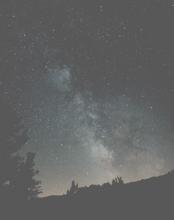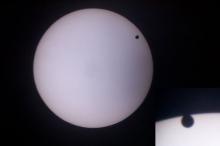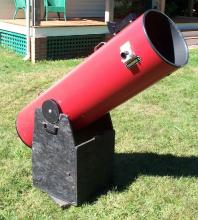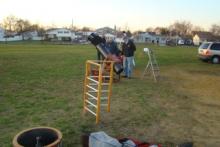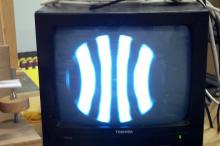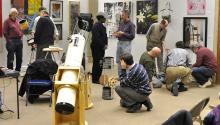Don't miss the meeting, coming up this week!
Science Daily

Astronomy news. New! Earth-like extrasolar planet found; double helix nebula; supermassive black holes, astronomy articles, astronomy pictures. Updated daily.
Updated: 20 hours 53 min ago
Gas on the run -- ALMA spots the shadow of a molecular outflow from a quasar when the Universe was less than one billion years old
Theoretical predictions have been confirmed with the discovery of an outflow of molecular gas from a quasar when the Universe was less than a billion years old.
Bright galaxies put dark matter to the test
The earliest galaxies are thought to have formed as the gravitational pull of dark matter, which has been impossible to study directly, slowly drew in enough hydrogen and helium to ignite stars. But astrophysicists now show that after the Big Bang, hydrogen and helium gas bounced at supersonic speeds off dense, slowly moving clumps of cold dark matter. When the gas fell back in millennia later, stars formed all at once, creating small, exceptionally bright galaxies. If models of cold dark matter are correct, the James Webb Space Telescope should be able to find patches of bright galaxies in the early universe, potentially offering the first effective test for theories about dark matter. If it doesn't, scientists have to go back to the drawing board with dark matter.
The hottest catalog of the year: Comprehensive list of slow-building solar flares
Although solar flares have been classified based on the amount of energy they emit at their peak, there has not been significant study into differentiating flares since slow-building flares were first discovered in the 1980s. Scientists have now shown that there is a significant amount of slower-type flares worthy of further investigation.
Staggering structure in 19 nearby spiral galaxies
The James Webb Space Telescope observed 19 nearby face-on spiral galaxies in near- and mid-infrared light as part of its contributions to the Physics at High Angular resolution in Nearby GalaxieS (PHANGS) program.
Researchers spying for signs of life among exoplanet atmospheres
The next generation of advanced telescopes could sharpen the hunt for potential extraterrestrial life by closely scrutinizing the atmospheres of nearby exoplanets, new research suggests.
Astronomers spot 18 black holes gobbling up nearby stars
Scientists have identified 18 new tidal disruption events (TDEs) -- extreme instances when a nearby star is tidally drawn into a black hole and ripped to shreds. The detections more than double the number of known TDEs in the nearby universe.
Cosmic building blocks of life discovered through the electron microscope
Meteorites are fragments of asteroids which find their way to Earth as shooting stars and provide information on the origins of our solar system. A team of researchers has examined the so-called Winchcombe meteorite and demonstrated the existence in it of nitrogen compounds such as amino acids and heterocyclic hydrocarbons -- without applying any chemical treatment and by using a new type of detector design.
Astronomers unravel mysteries of planet formation and evolution in distant planetary system
TOI-1136, a dwarf star located more than 270 light years from Earth, is host to six confirmed exoplanets and a seventh as yet unconfirmed candidate. The system has provided a rich source of information on planet formation and evolution in a young solar system. Researchers used a variety of tools to compile radial velocity and transit timing variation readings to derive highly precise measurements of the exoplants' masses, orbital information and atmospheres.
Stars travel more slowly at Milky Way's edge
Physicists discovered stars near the edge of the Milky Way travel more slowly than those closer to its center -- a surprise suggesting our galaxy's gravitational core may have less dark matter than previously thought.
'Old smokers' and 'squalling newborns' among hidden stars spotted for first time
'Hidden' stars including a new type of elderly giant nicknamed an 'old smoker' have been spotted for the first time by astronomers. The mystery objects exist at the heart of our Milky Way galaxy and can sit quietly for decades -- fading almost to invisibility -- before suddenly puffing out clouds of smoke, according to a new study.
Faint features in galaxy NGC 5728 revealed
A new study describes the best method to improve images obtained by the James Webb Science Telescope (JWST) using a mathematical approach called deconvolution.
Astrophysical jet caught in a 'speed trap'
The microquasar SS 433 stands out as one of the most intriguing objects within our Milky Way. A pair of oppositely directed beams of plasma ('jets') spirals away perpendicularly from the binary systems disk's surface at just over a quarter of the speed of light. The H.E.S.S. observatory in Namibia has now succeeded in detecting very high energy gamma rays from the jets of SS 433, and identifying the exact location within the jets of one of the galaxy's most effective particle accelerators.
Lightest black hole or heaviest neutron star? MeerKAT uncovers a mysterious object in Milky Way
An international team of astronomers have found a new and unknown object in the Milky Way that is heavier than the heaviest neutron stars known and yet simultaneously lighter than the lightest black holes known.
Moon rocks with unique dust found
A research team has for the first time discovered anomalous meter-sized rocks on the lunar surface that are covered in dust and presumably exhibit unique properties -- such as magnetic anomalies. These findings help to understand the processes that form and change the lunar crust.
Origin of intense light in supermassive black holes and tidal disruption events revealed
A new study is a significant breakthrough in understanding Tidal Disruption Events (TDEs) involving supermassive black holes. The new simulations accurately replicate the entire sequence of a TDE from stellar disruption to the peak luminosity of the resulting flare.
Astronomers detect oldest black hole ever observed
Researchers have discovered the oldest black hole ever observed, dating from the dawn of the universe, and found that it is 'eating' its host galaxy to death.
The metalens meets the stars
Researchers have developed a 10-centimeter-diameter glass metalens that can image the sun, the moon and distant nebulae with high resolution. It is the first all-glass, large-scale metalens in the visible wavelength that can be mass produced using conventional CMOS fabrication technology.
Study delivers detailed photos of galaxies' inner structures
High-resolution images captured by the James Webb Space Telescope are offering powerful insights into the complex dust patterns of nearby star-forming galaxies.
Astronomers produce most sensitive radio image ever of ancient star cluster
Astronomers have created the most sensitive radio image ever of a globular cluster, an ancient ball of tightly-packed stars.
Earth-sized planet discovered in 'our solar backyard'
Astronomers have discovered a planet closer and younger than any other Earth-sized world yet identified. It's a remarkably hot world whose proximity to our own planet and to a star like our sun mark it as a unique opportunity to study how planets evolve.


